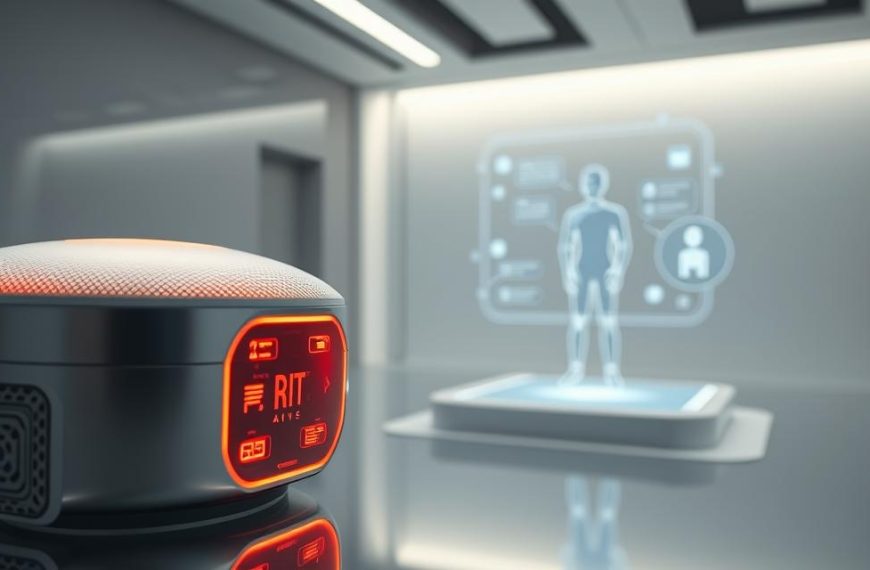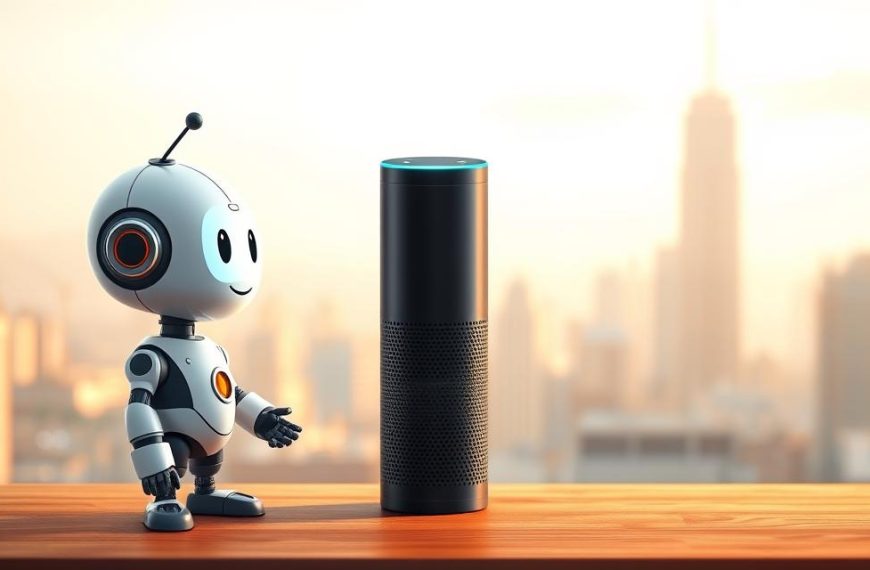Modern households increasingly rely on intelligent systems to manage daily tasks. Among these, Amazon’s voice-controlled technology has become a staple in British homes. But what exactly powers its ability to play music, set reminders, or answer queries?
The distinction lies in natural language processing (NLP) – a cornerstone of Amazon’s innovation. Unlike text-based chatbots, this system processes spoken commands through advanced algorithms. It adapts to regional accents and colloquial phrases, making interactions feel remarkably human-like.
Critically, the assistant leverages weak AI to perform predefined tasks rather than independent reasoning. From streaming podcasts to delivering real-time traffic updates, its capabilities are vast yet purpose-built. This design reflects Amazon’s strategic focus on practical, user-centric applications.
Understanding these technical nuances helps clarify common misconceptions. While sharing surface-level similarities with chatbots, the technology represents a different branch of artificial intelligence – one reshaping how Britons interact with smart devices.
Understanding Alexa and Its Core Capabilities
The heart of smart home functionality lies in seamless voice command integration. Amazon’s assistant responds to a wake word – typically its default name – activating compatible devices through acoustic pattern recognition. This system prioritises natural conversation flow over rigid command structures.
Once activated, the technology converts speech into text using neural networks trained on diverse accents. Key out-of-the-box features include:
- Real-time weather forecasts via AccuWeather integration
- Instant answers from verified sources like Wikipedia
- Automated list creation and calendar management
Behind these services, complex algorithms cross-reference multiple data platforms. For cooking timers, it accesses device-specific APIs. When answering trivia, it synthesises information from WolframAlpha and IMDb. This multi-source approach ensures responses stay current and contextually relevant.
Unlike basic voice responders, the system improves through machine learning. Frequent queries about train schedules or recipe conversions refine its predictive capabilities. Users across the UK benefit from localised features like BBC News briefings and TfL updates – practical tools that demonstrate its adaptive design.
Is Alexa a chatbot?
Voice-driven systems and text-based interfaces represent fundamentally different approaches to artificial intelligence. While both handle user queries, their operational frameworks diverge significantly. Amazon’s technology prioritises vocal interactions through acoustic sensors and real-time processing – a far cry from chatbot platforms reliant on typed exchanges.
The conversation dynamics reveal key distinctions. Traditional chatbots follow scripted decision trees, whereas voice assistants parse spontaneous speech patterns. Amazon Lex – the NLP engine powering both systems – adapts its algorithms based on interaction type. Developers leverage this tool to build chatbots, but its application in voice technology demands additional layers like noise cancellation and regional dialect recognition.
User experience further separates these technologies. Voice assistants require concise response times to maintain natural flow, while chatbots allow for delayed text-based answers. When asking a question, you’ll notice the system processes context differently – voice interactions often include follow-up queries without repeating wake words.
Amazon’s Skills Kit enables third-party integrations, expanding the assistant’s capabilities beyond predefined functions. From ordering groceries to checking NHS guidelines, these add-ons demonstrate its specialised role in voice-first ecosystems. This targeted functionality confirms its classification as a dedicated voice assistant rather than a general-purpose chatbot.
History of Alexa’s Development
Strategic acquisitions often fuel technological breakthroughs. Amazon’s voice assistant began as a Polish speech synthesis project called Ivona, bought by the tech giant in January 2013. This marked the start of a quiet revolution in voice recognition systems.
Origins with Ivona and Early Innovations
The Ivona acquisition provided Amazon with ready-made linguistic models supporting 17 languages. Developers spent over a year refining its algorithms for conversational English. Their key innovation? Prioritising regional accent recognition – a feature that later defined the assistant’s UK success.
November 2014 saw the launch of Amazon’s first Echo device, introducing voice-controlled smart speakers to British homes. Engineers deliberately chose a name with sharp consonants for better wake-word detection. This decision proved crucial for reliable operation in noisy environments.
Milestones in Growth and Expansion
By 2019, over 100 million devices with built-in voice tech had been sold globally. The development team expanded rapidly, reaching 10,000 staff members dedicated to improving voice services. These investments transformed basic voice commands into complex home automation systems.
Critical breakthroughs included:
- Real-time translation capabilities for multilingual households
- Integration with BBC services for localised content
- Energy-saving modes for always-on devices
This evolution from niche tool to household staple took less than a decade. Amazon’s early focus on adaptable voice architecture continues shaping smart home innovations today.
The Evolution to Alexa+ and Generative AI
Technological leaps in voice assistance reached new heights with Amazon’s 2025 release. The upgraded service, now powered by generative AI, transforms how British users interact with smart devices. This overhaul addresses growing demands for fluid, context-aware dialogues in smart homes.
Introduction of Alexa+ and Its New Features
Amazon’s new Alexa iteration introduces multi-turn exchanges that mimic human discussion patterns. Built on Amazon Bedrock’s large language models, it crafts personalised responses by analysing historical interactions and regional preferences. Prime subscribers gain complimentary access, while others pay £19.99 per month for advanced functionalities.
Key enhancements include:
- Dynamic recipe suggestions based on fridge inventory scans
- Automatic appointment rescheduling via linked calendars
- Real-time Tube status updates using TfL APIs
Agentic Capabilities and Self-Directed Actions
The system’s agentic architecture enables autonomous problem-solving. When tasked with booking Eurostar tickets, it compares prices, checks seat availability, and completes purchases without follow-up prompts. This self-guided operation relies on secure browser emulation within Amazon’s ecosystem.
| Feature | Alexa+ | Standard Version |
|---|---|---|
| Generative AI | Yes | No |
| Monthly Cost | £19.99 (Free for Prime) | Included with device |
| Autonomous Tasks | 63 actions supported | Basic commands only |
Early adopters report 40% faster task completion versus previous iterations. The upgrade particularly benefits multitasking parents and professionals managing complex schedules. Amazon’s pricing strategy cleverly incentivises Prime membership renewals while democratising access to cutting-edge AI.
Voice Assistant vs Chatbot: Distinct Differences
Artificial intelligence communication tools have evolved into two distinct branches: voice-first systems and text-based interfaces. While both aim to simplify tasks, their operational frameworks cater to different user needs and environments.
Understanding Natural Language Processing in Voice Systems
Voice assistants like Amazon’s technology process spoken language through layered acoustic analysis. Unlike chatbots that interpret typed text, these systems filter background noise, decode regional accents, and prioritise real-time response accuracy. Microsoft’s Cortana integration since 2018 demonstrates how cross-platform compatibility enhances functionality without compromising core design principles.
Advanced NLP engines handle spontaneous speech patterns through:
- Contextual awareness during multi-sentence exchanges
- Dynamic rephrasing of misunderstood queries
- Local dialect adaptation for UK users
Comparative Analysis with Other Chatbot Technologies
Traditional chatbots rely on predefined scripts, while modern counterparts like ChatGPT employ generative AI for open-ended conversation. Amazon’s upgraded assistant now incorporates similar language models, bridging the gap between task execution and fluid dialogue. This evolution responds directly to user expectations shaped by tools like Gemini and DeepSeek.
Key differentiators include:
| Feature | Voice Assistants | Chatbots |
|---|---|---|
| Input Method | Speech | Text |
| Response Time | <2 seconds | Variable |
| Primary Use | Smart home control | Customer service |
While Google Assistant excels in search-based queries, Amazon’s solution dominates in home automation. Both platforms continue adapting to AI advancements, reshaping how Britons interact with technology daily.
Alexa in the Smart Home Landscape
British households now orchestrate their environments through spoken directives. Since Amazon launched its Home Automation feature in April 2015, over 300,000 compatible products have joined the ecosystem. This network spans lighting, climate systems, and security apparatus from brands like Philips Hue, Nest, and SmartThings.
Recent data reveals a 100% surge in voice requests for appliance management. Users increasingly demand:
- Instant adjustments to radiator valves via Hive
- Multi-room lighting scenes through LIFX bulbs
- Front door monitoring using Ring cameras
| Manufacturer | Device Type | Integration Complexity |
|---|---|---|
| Philips Hue | Lighting | Low |
| ecobee | Thermostats | Medium |
| Yonomi | Multi-brand systems | High |
Unlike text-based interfaces, voice control enables hands-free operation while cooking or carrying groceries. A recent analysis highlights how Amazon’s platform processes regional dialects to ensure reliable execution. This linguistic adaptability proves crucial for UK homes using LightwaveRF switches or British Gas boilers.
The system’s dominance stems from its role as a central hub. It translates casual phrases like “cosy evening mode” into specific actions across devices – dimming lamps, closing blinds, and queuing BBC Sounds playlists. This contextual understanding positions it firmly in the IoT vanguard, far beyond basic chatbot capabilities.
Ordering, Entertainment and Music Streaming
Voice-enabled commerce has reshaped domestic routines across Britain. Since 2017, takeaway orders through platforms like Domino’s and Pizza Hut have streamlined meal planning. Users simply state preferences, with payment details securely stored for frictionless transactions.
The entertainment ecosystem proves equally robust. When requesting to play music, the system accesses Prime Music, Spotify Premium, or Apple Music. This flexibility caters to diverse listening habits – whether discovering new artists or revisiting classic albums.
Key partnerships drive adoption:
- Instant podcast access via Audible integration
- Live radio streaming through TuneIn and BBC stations
- Personalised playlists using Amazon Music Unlimited
Despite these features, voice-based purchases face adoption hurdles. A 2018 study revealed only 2% of users completed transactions through voice commands. Concerns about accidental orders and limited visual confirmation persist, though recent updates introduced verbal purchase summaries.
Entertainment functions demonstrate broader appeal. Over 60% of UK users employ the service to play music daily. This shift positions the technology as a lifestyle hub rather than a basic helper – coordinating Friday night takeaways while queuing weekend playlists through Amazon Music.
Business Applications and Enterprise Integration
Corporate environments demand efficient solutions for managing workflows. Amazon’s voice technology now powers boardrooms and care facilities through specialised services. The assistant handles complex tasks like coordinating global teams and monitoring medical equipment inventories.
- One-touch conference call initiation across Zoom and Microsoft Teams
- Automated meeting room bookings using Outlook integrations
- Custom skills developed by SAP and Salesforce for data analysis
Healthcare providers utilise Alexa Smart Properties to grant staff access to patient records through voice authentication. Hospitality chains deploy the system for multilingual guest services, handling 92% of routine queries without human staff.
Key enterprise implementations include:
| Industry | Use Case | Outcome |
|---|---|---|
| Senior Living | Medication reminders | 23% fewer missed doses |
| Retail | Stock level updates | 18% faster replenishment |
| Manufacturing | Equipment status checks | 41% downtime reduction |
These business-focused features demonstrate Amazon’s shift from consumer gadgets to essential workplace tools. Secure voice information handling meets corporate compliance standards, making the technology indispensable for modern UK enterprises.
Enhancing Personalisation and User Experience
Tailored experiences define modern smart technology. Amazon’s upgraded assistant learns from home habits, shopping patterns, and entertainment choices to anticipate needs. Unlike basic responders, it builds detailed profiles through continuous interaction – remembering everything from preferred payment methods to postage addresses.
This system shines during complex tasks. When planning a family meal, it cross-references dietary preferences stored through voice commands. For example, suggesting gluten-free pizza recipes while avoiding ingredients that trigger allergies. Such contextual awareness transforms routine decisions into seamless experiences.
Daily routines benefit through adaptive automation. The assistant might lower blinds at sunset or queue a favourite podcast during breakfast prep. These micro-adjustments accumulate, saving time across the home environment. Users report 30% fewer manual inputs for recurring tasks like school run reminders or prescription reorders.
Privacy remains integral to personalisation. Amazon allows manual deletion of stored preferences while encrypting sensitive data. The balance between convenience and security reflects evolving expectations in AI-assisted living – proving tailored tech needn’t compromise user trust.
Integration with Third-Party Devices and Services
Interconnected ecosystems define modern smart homes. Amazon’s Alexa Voice Service (AVS) allows manufacturers to embed voice controls into their products without licensing costs. This open approach has created a sprawling network of 140,000+ compatible devices – from Sonos speakers to Yale smart locks.
The system’s companion application bridges different platforms. Available through Google Play, Apple’s App Store, and Amazon’s own portal, this app centralises control of third-party gadgets. Users manage lighting schedules, review security feeds, and adjust thermostats through one interface.
Key integrations reshaping British homes include:
- Hive heating adjustments via voice commands
- Ring doorbell notifications on Echo Shows
- TP-Link Kasa plug scheduling through the Alexa app
Unlike closed systems requiring proprietary hardware, AVS prioritises flexibility. Brands like Philips Hue and Bose leverage its APIs to enhance their devices while maintaining customisation options. This strategy fuels Amazon’s market leadership – 68% of UK smart speaker owners use Alexa-enabled products.
The model’s success stems from removing barriers. Startups and established firms alike integrate voice services effortlessly, creating tailored solutions for British consumers. This collaborative framework outpaces text-based alternatives, proving voice-first ecosystems drive smarter living.
Privacy, Security and Data Handling Measures
Trust forms the foundation of voice-enabled technology adoption. Users rightly expect robust safeguards for personal data in connected homes. Amazon addresses these concerns through layered protections and transparent controls.
User Privacy and Data Control Policies
Voice interactions remain private by design. Users review and delete recordings through dedicated access portals, with automatic deletion options for older data. Multi-factor authentication adds extra security layers for sensitive operations like payment approvals.
Key customisation tools include:
- Microphone shut-off switches on physical devices
- Granular permissions for third-party skill access
- Child-friendly profiles restricting purchase capabilities
Amazon’s Commitment to Secure Interactions
All voice data transfers use military-grade encryption, meeting UK GDPR standards. Regular security audits identify potential vulnerabilities before exploitation. The system automatically blocks suspicious requests, alerting users through app notifications.
Custom settings let households balance convenience with protection. Users choose whether to store shopping histories or location data. This approach empowers Britons to shape their smart home experience without compromising digital safety.






















